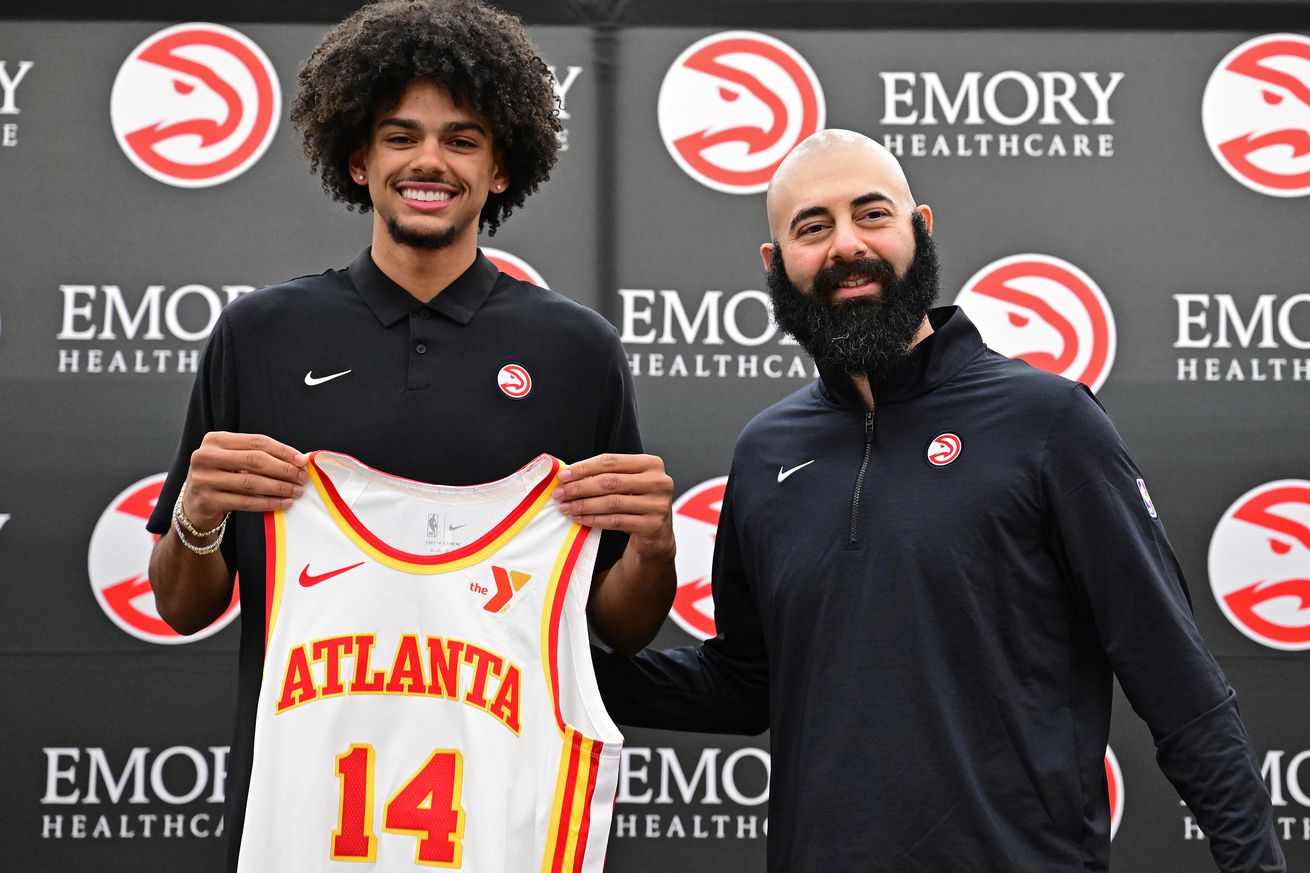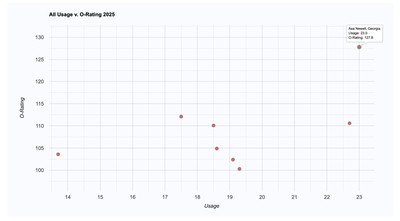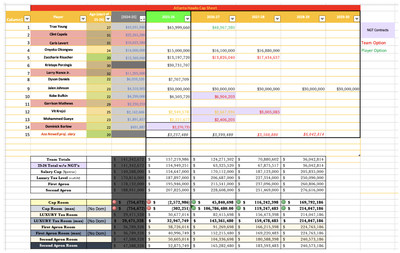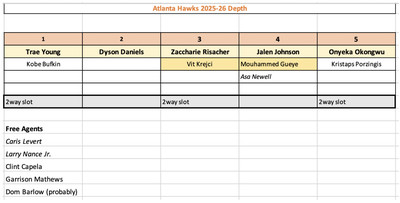
A few intriguing numbers on Kristaps Porzingis, Asa Newell. Plus, areas of need for Atlanta in free agency.
What a week for Onsi Saleh and the Atlanta Hawks front office!
The Hawks kicked off NBA Draft week with a bang – agreeing in principle to a deal to acquire flamethrowing big man, Kristaps Porzingis, as well as a 2026 second-rounder from the Boston Celtics in exchange for Georges Niang, Terance Mann, the no. 22 pick in this year’s draft, and a 2031 second-round pick via Cleveland. Mann (and the remaining $47 million owed to him over the next three years) and no. 22 were rerouted to Brooklyn as part of the trade.
Then, during the first round of the draft on Wednesday night, the Hawks agreed to trade the no. 13 pick to New Orleans in exchange for the no. 23 pick, as well as an unprotected 2026 first-rounder (the more favorable of New Orleans’ and Milwaukee’s selections). New Orleans drafted Maryland big man, Derik Queen, at no. 13, while the Hawks selected Asa Newell out of UGA with the no. 23 pick.
Both moves were widely praised around the NBA community. Porzingis, when healthy, provides the Hawks with a unique blend of shooting and rim-protection at the ‘5’. Per stathead, he is one of just five players since 2022-23 to make at least 1.9 threes per game, and post a block percentage of at least 4% over the course of a single season – and is the only player in this group to have achieved this feat multiple times over this span. His presence raises Atlanta’s ceiling on both sides of the ball.

As for the draft night deal, it’s hard to come from that trade feeling anything but thrilled for Atlanta and equally confused with the Pelican’s thought process. Looking at the visual from Todd Whitehead below (a fantastic follow on Twitter if you’re not following him already), there isn’t an overwhelming difference in terms of the ‘most common outcome’ between players picked at no. 13 and no. 23. Yet, New Orleans – who finished 21-61 and ranked 29th in defensive rating last season – felt strongly enough about Queen to sacrifice what is projected to be a top-ten pick in next year’s draft in order to move up ten slots to get him.
Or re-organized to show the most common outcome for players from each draft slot: pic.twitter.com/GAIYJ6TkMR
— Todd Whitehead (@CrumpledJumper) June 26, 2025
While front offices will typically pay a premium price to get “their guy” in the draft, the general consensus around the league is that New Orleans gave up way too much in this trade, with one Western Conference assistant GM calling it “the worst trade, non-Luka division, that we’ve seen in the last decade,” per Sam Vecinie of The Athletic. This is, of course, music to the ears of Hawk’s fans, who have to be feeling reinvigorated by their new-look, Onsi Saleh-led front office after this week’s events.
Today, let’s highlight a few interesting numbers on Kristaps Porzingis and Asa Newell, before briefly taking a look at some areas of need for Atlanta as the league shifts its focus towards free agency.
Kristaps Porzingis
Age (start of 2025/26 season): 30
Height: 7’2”
Weight: 240

40.1% – C&S 3P% since 2022-23
As you’ve likely heard by now, Porzingis is one of the best three-point shooting bigs in the NBA, and the number that should excite Hawks fans the most is his stellar 40.1% conversion rate on catch-and-shoot threes over the past three seasons. These looks have made up over 90% of his three-point attempts over this span, and for a Hawks team that’s seen an uptick in ball movement over the past two and a half seasons under Quin Snyder, Porzingis’ ability to stretch defenses with his floor spacing should fit in nicely.
His proficiency off the catch (particularly from above the break), not only gives Trae Young a dynamite pick-and-pop partner to work with, but will also draw opposing bigs out of the paint and create more room for Young, Dyson Daniels, and Jalen Johnson’s to operate on drives/cuts to the hole. Atlanta ranked just 22nd in rim field goal percentage last season which was one of the biggest detriments to their offense as a whole (which ranked 17th last season). Porzingis’ shooting ability should help Atlanta improve their efficiency at the rim as well.
1.22 – PPP on post-ups since 2022-23
While Porzingis’ shooting has understandably grabbed most of the headlines, another important aspect of his offensive game is his ability to score out of the post. Post ups have made up nearly 20% of his scoring possessions over the past three seasons, and he has routinely ranked near the top of the league in both volume and efficiency on these types of possessions. In fact, per nba.com/stats, Porzingis’ 1.22 points per possession (PPP) on post ups ranks no. 1 in the league amongst players who have averaged at least 2 post-up possessions per game since 2022-23.
Interestingly, the Hawks ranked dead last in post up playtype frequency last season, with these possessions making up just 1.4% of the team’s scoring playtypes in 2024-25. Porzingis ran more post ups by himself in 42 regular season appearances (149), than the Hawks did as a team (137) last season, so I’ll be curious to see how Quin Snyder and his coaching staff plan to incorporate this part of his game into the offense next season.
65 – Games missed over the past two seasons
It’s difficult to find fault with Porzingis’ on-court fit in Atlanta. He’s an NBA champion and an analytics darling who undoubtedly raises Atlanta’s ceiling next season. The concern when it comes to him is that he has a hard time staying on the court in the first place. Since returning from an ACL tear that kept him out for the entire 2018-19 season, he’s managed to play in more than 57 regular season games just once in the last six seasons.
Over the past two seasons in Boston, he’s dealt with a number of lower body injuries – including two (a right soleus strain and a left posterior tibialis dislocation) that kept him sidelined for much of Boston’s playoff run in 2024, though he was still able to play limited minutes and make an impact in the NBA Finals. Last season, he missed the start of the year recovering from an off-season surgery, then dealt with a strange “upper respiratory, non-COVID illness” during the second-half of the season which significantly hindered his ability to perform in the Playoffs.
While the upside of a healthy Porzingis is certainly worth the gamble, the injury history is a cause for concern and the Hawks would do well to have a rock-solid contingency plan in place in the event that Porzingis misses time.
Asa Newell
Age (start of 2025/26 season): 20
Height: 6’9”
Weight: 223

127.8 – Georgia’s offensive rating with Newell on the floor
While Newell is projected to contribute more on defense than on offense at the NBA level, it’s worth noting just how big of an impact he had on Georgia’s offense as a college freshman last season. The Bulldogs ranked 52nd in the country in offensive rating (115.8) in 2024-25, however in their minutes with Newell on the court, they posted an offensive rating of 127.8 – on par with Alabama’s offense which ranked 3rd in the country.
Looking at the chart below (from Bart Torvik), which plots offensive rating against usage rate for Georgia’s players who played at least 20% of the team’s minutes last season, you can see that nobody else on the team even came close to replicating Newell’s on-court offensive impact.

It’s important to keep in mind that Newell primarily played at the ‘5’ in college, as opposed to the ‘4’ where he’ll likely see the majority of his minutes in the NBA. Nonetheless, his ability to impact the game on the glass (14.0% offensive rebound percentage), in the paint (67.3% rim field goal percentage in the halfcourt), and in transition (Newell shot 21-of-22 (!) at the rim in transition) clearly worked wonders for Georgia’s offense last season.
29.2% & 74.8% – Newell’s college 3P% & FT%
After shooting just 29.2% from three (on 2.7 attempts per game) at Georgia, it’s no secret that Newell’s ability to shoot from the outside is one of the most important parts of his game to develop if he is going to carve out a role for himself as an NBA ‘4’.
While his mid-range field goal percentage (37.3%) in college might indicate that his shooting touch needs a bit of work, Hawks’ fans can at least take solace in the fact that he shot an encouraging 74.8% from the free-throw stripe – indicating at the very least, that the shot isn’t broken.
2.78 seconds – shuttle run time at the NBA Combine (5th amongst Combine participants)
On the defensive end, Newell’s greatest asset is the speed and agility he brings to the table at his size, something that was confirmed by his impressive shuttle run and lane agility times at the NBA Combine. In Chicago, Newell posted the fifth fastest time amongst all players in the shuttle run, and the eighth fastest time amongst forwards and centers in the lane agility drill. Newell’s athletic gifts help him cover a ton of ground in rotation, impact shots at the rim (3.8% block percentage) and comfortably switch 1-through-5 at the college level. His versatility was at the heart of Georgia’s 30th ranked defense last season.
Against NBA competition, Newell will have to add some muscle in order to defend against 5s*, and he will be tested by the quickness of NBA guards, but he has a great foundation to build upon and should develop into an impactful defensive player sooner rather than later.
*For reference, Onyeka Okongwu is 6’9” and weighs 240 pounds, and is still seen as undersized for an NBA ‘5’
Setting the table for Free Agency
Before we go, I wanted to share an updated version of Atlanta’s cap sheet and depth chart ahead of free agency.
Cap

As you can see from the cap-sheet above, assuming Atlanta guarantees the contracts for Vit Krejci and Mouhamed Gueye and declines the team option on Dominick Barlow, they will enter the offseason $33 million below the luxury tax line and $41 million below the first apron with ten players on the roster (out of the maximum of 15) for next season.
The Hawks can exceed the cap to resign their own free agents and will have access to the $14.1 million non-taxpayer mid-level exception (MLE*) — as well as the $5.1 million bi-annual exception to sign players on the free agent market. Additionally, they have a $25.3 million trade exception (which expires on July 7th) that they can use to acquire players from other teams without having to send out matching salaries in a deal.
*provided that they stay below the first apron
Depth

Looking at the depth chart, you can see that while the Hawks’ have quite a formidable top-six after the Porzingis trade, it’s going to be vital for them to fill out their bench with quality role players to complement the current group.
As things stand, unproven third-year man, Kobe Bufkin – whose injury woes have resulted in him making just 27 NBA appearances since being drafted 15th overall in 2023 – is the only back-up guard on the roster. Vit Krejci, who had a usage rate of just 13.1%, but posted a 3:1 assist to turnover ratio and shot 43.3% from the perimeter (56.7% after the All-Star break) last season, is the only back-up wing.
In the frontcourt, while I’d feel good about Mouhamed Gueye and either Porzingis or Onyeka Okongwu manning the backup ‘4’ and ‘5’ minutes*, given the respective injury histories of Gueye, Porzingis and Jalen Johnson, the Hawks need to add some depth here as well.
*I wouldn’t be surprised if first-round pick, Asa Newell, starts the season in the G League with the College Park Skyhawks. Additionally, I’ve got Okongwu penciled in as the starter for now due to Porzingis’ injury history, the fact that he’s on a one-year deal, as well as Okongwu’s impressive play over the second half of the 2024-25 season.
Essentially, the Hawks need to add a back-up guard, a back-up wing, and a back-up level big.
It’s been reported that the Hawks are interested in bringing back both Caris LeVert and Larry Nance Jr. – moves that I’d be perfectly alright with as LeVert is versatile enough to play both on and off the ball, while Nance Jr. has experience playing both the 4 and the 5 (even if he is a bit undersized for extended stretches at the 5 at 6’8”).
That being said, if the team is really trying to go for it next season (as the Porzingis trade suggests), I personally believe that they’d be one high-level, two-way wing short of being legitimate contenders for the Eastern Conference Finals even after bringing back Levert and Nance Jr.
One intriguing option is Minnesota Timberwolves wing, Nickeil Alexander-Walker, who will be a restricted free agent this summer, but is reportedly a name to watch for the Hawks in a potential sign-and-trade. Apart from Alexander-Walker, the free agent isn’t exactly overflowing with wing talent this year (can I interest anyone in Kelly Oubre Jr., Alec Burks, or Taurean Prince? Didn’t think so), which is where the $25.3 million trade exception comes into play.
The Hawks could acquire a player like Brooklyn’s Cam Johnson (who shot 39% from three on 7.2 attempts per game in 2024-25), Phoenix’s Dillon Brooks, or Washington’s Marcus Smart. Additionally, Blazers’ forward, Deni Avdija, Celtics wing, Sam Hauser, or Suns forward (and former Quin Snyder player), Royce O’Neale, could be options as well.
Simply put, if Onsi Saleh is to continue in this vein of making aggressive moves, I’d be surprised if this significant trade exception doesn’t come into play over the next few days. Free agency begins at 6 PM EST on June 30th, which is when teams can start to negotiate with players. Players can officially sign contracts on June 6th.
It’s been an exciting offseason so far in Atlanta, and these next two weeks should be no different. I can’t wait to see what the Hawks’ front office cooks up.
Stay tuned!
All statistics used are from basketball-reference.com, nba.com/stats, cleaningtheglass.com, dunksandthrees.com, sports-reference.com, and bball-index.com. Salary info is from Spotrac and RealGM.
